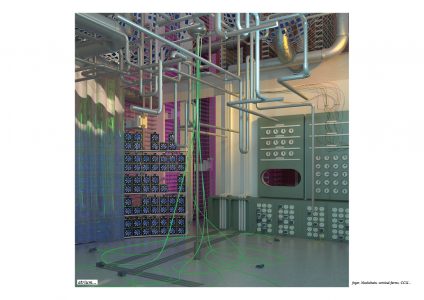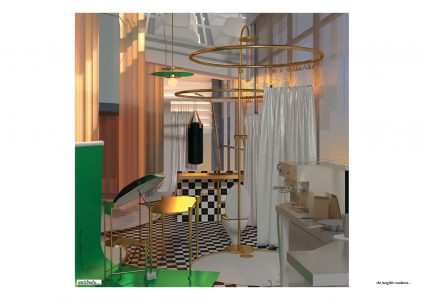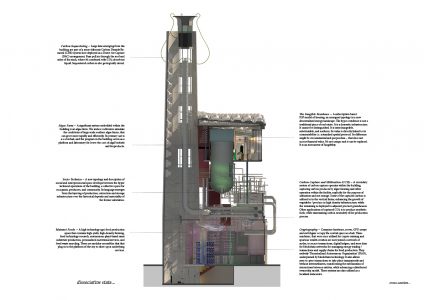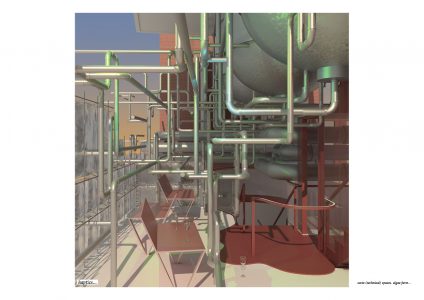





Vis Viva – Transcending a Crypto Winter
The project is a spatial manifesto contained within a building, prompted by a seemingly inert consideration – the imminent technical change from non-renewable to renewable energy. But here, repositioned to be projective and operative, to develop into a catalyst for a new dimension of temporal architecture and urbanism. It is an advocacy through the built environment to consider emergent opportunities and latent potentials of a new energy architecture and its material realities. The proposition seeks to reorganise the relationships within the built environment around an ecosystem of localised renewable energy and production. ‘Vis Viva’, (i.e. ‘living force’) denotes the vital essence of motion in relation to energy. Here architecture is conceptualised in a paradigm of conservation of energy, between abundance and scarcity, and from estrangement and entanglement to equilibrium, where the built fabric is where energy is both potential and kinetic.
0_Sustainable Development Guidelines
The project corresponds to the UN SDG 7 ‘Affordable and Clean Energy and the goals that by 2030 to provide affordable and reliable energy services, to significantly increase the use of renewable energy sources in the global energy mix, to double the global rate of improvement in energy efficiency, to promote international cooperation in clean energy research and technology, as well as investment in clean energy infrastructure.
1_Antifragile and the City as a Service
The project is premised on Nassim Taleb’s concept of ‘Antifragile’ – the proposition that complex systems can benefit from shocks and thrive when exposed to randomness and disorder. Climate change, energy crises, distributed platform technologies, neoliberal and free-market oriented instability collectively create a network of risk and volatility. The project extends this discourse of antifragility as a design methodology to contend with architectural principles for buildings and cities that are articulated as adaptable and flexible systems that respond to changing conditions.
The urban realm is negotiated through the lens of the City as a Service, that sets in motion the city as an end-to-end process, for transactions, end points, interfaces. Its urbanism is a by-product of a distributed field of open-source and proprietary variables meeting capacities and performance requirements independently and autonomously. Infinite loops and endless binaries – cities on the cusp of a singularity.
Existing buildings and prevailing city blocks become decentralised scalable hubs of energy production, storage, and modular centres of food production. It seeks the agency of architecture and in the instrumentality of the built environment as pivotal variables in energy transitions and mitigation efforts reducing emissions through the provision of hosting infrastructures for adaptable temporal arrangements to accommodate and accelerate localised energy and food production. The approach also recognises redundancy (and not only efficiency) as a critical variable for resilience. The new energy infrastructure will become a catalyst for hybrid building models, new instruments of property, novel formats of subscription housing, shared ownership models and the city as a service.
2_Energy, Architecture
Architecture since the industrial age (at the very least) too, is conceptualised in the paradigm of abundant, cheap energy, namely from carbon. Brian Cody notes ‘form follows energy’, and ‘architecture is energy’ , which in summary captures a broad discourse on architecture’s deep and enduring association with energy and material flows. Architecture and cities are arguably an attempt to optimise and therefore manifest energy flows.
How might a technical change to the from non-renewable to renewable energy become a catalyst for a new dimension of temporal architecture and urbanism? How do we embrace the latent potential of a new energy architecture and its material realities? How to we reorganise the relationships within the built environment around an ecosystem of localised energy production?
3_Bloackchains, Platforms, Distribution
Adjacent to this interest, the project also contends with the emergent paradigm of peer-to-peer economies, platform and decentralised technologies, that ally with and accelerate the transformation of distributed urban structures. They proffer scenarios that are analogous to multi-nodal arrangements and polycentric city models. While blockchain technologies present opportunities for scalability, transparency, security and democratising variables for industry, supply chains and governance, presently, the technology; with its computational demands, decentralised hardware and redundancies it is inefficient (especially when powered by fossil fuel). Crypto mining which is the process of creation of cryptocurrency and subsequent progressions of verifying ledgers generates a labyrinth of digital transactions that are resource intensive processes. Its misappropriation and misapplication at the hands of ‘cypherpunks’ is staggeringly careless, left unfettered, it succumbs to its own latent determinism.
Cryptocurrency have tumbled, trading volume have cratered, and several high-profile companies and exchanges have collapsed in liquidity crises. In its current guise, cryptography and blockchains present an ominous scenario of technology and its influence over society, where the market is volatile, the boosters are eccentric, the believers are resilient, and the opportunity is latent in the anarchy and chaos. The current prolonged bear-market in cryptocurrency is colloquially referred to as a Crypto Winter.
How could these advanced platforms, infrastructures, networks, and technologies… blocks and chains be redirected too emergent Can the crypto winter become a moment of introspection and redressal?
The project imagines a renewed realm crypto enthusiasts and decentralised communities, emerging from the shadow of a crypto winter. Blockchain and cryptography are a necessary step towards the organisation of a decentralized future. The virtual wastelands and foiled attempts of revolutionary wealth creation are metamorphosed into a new energy landscape, distributed platforms that are reconstituted within urban and suburban allotments, blocks and precincts. Prevailing hierarchies are reordered, existing buildings reutilised, infrastructure augmented.
4_Staging
The project Vis Viva is rolling back from a threshold of technological determinism. It is concerned with the re-forming and re-organisation of architecture in response to shifting energy paradigms – from fossil fuels to renewable energy and its impact on the urban, architectural, and material realities of the built environment. It utilises decentralised distributed technological platforms as a digital backbone and aims to redeploy the hardware as a mechanism as a social infrastructure. We recognise that carbon as a store and source of energy led to contingent and particular societal behaviours and cultural objects. The cultural dynamics of complex systems are often overlooked in the comprehension of co-dependent systems. The project recognises the paradigm of energy is not only technological but also cultural. Crypto Winter is the recapitulation and redeployment of sequence scenarios and technologies as a bridging practice to empower local communities and culture.
The project is a seedbed for a modern energy ecosystem, where energy is formed without a grid and food is produced without soil and stored and distributed within the traditional description of an urban block.
The project acknowledges, that a liberation from carbon, will be a gradual, staged, process and through a design-research proposition articulates a spatial manifesto for temporal architectures and interventionist practices. and the instrumentality of the city and its architecture in the discourse of climate change resilience.
It incorporates and leverages the embodied energy of the existing built environment. The project is an alibi to interrogate the states of entanglement of the car, energy regimes and the architecture of the city… to understand new energy and the new possibilities for production and spatial organisation, that challenge the orthodoxies of cities, suburbs, precincts, and architecture, and to analyse and speculate on the temporary and permanent transformation of the city and urban realm.
Here Crypto Winter is deployed as a catch-all phrase to highlight the double-edged blade of technology, focussing on the redeployment imagines as a – The infrastructure, organisation, substructures, programmatic distribution, typologies, and archetypes emerge as armatures for a staged liberation from carbon and carbon form.
5_VisViva
The project and building utilises a defunct power substation in Melbourne, Australia. It is envisioned as a transactional exchange that perpetuates the idea of the city as an infrastructure and hosting environment. These services do not invent new forms or outlines but rather augment and interfere with the source code, the inputs and outputs and didacticism of the city. The project is a representative platform technology that provides a core set of underlying infrastructure services for investment and speculation.
The project is steered by individuals and social groups jacked into P2P infrastructures. Vis Viva is an urban project, retrofitting existing low-rise, low density building fabric. Typologically, is now a high technology energy and agri-food production space that contains infrastructure and systems for Carbon Sequestering – Direct Air Capture, and Carbon Capture Utilisation, Algae Farms, High Density Vertical Farms, a cryptographic exchange, Decentralised Autonomous Organisation (DAO), a data centre, social and entrepreneurial spaces, and a subscription residential service. These are modular assemblies that that plug in to the platform of the city to draw upon underlying services.
Vis Viva embodies a ‘Decentralized Autonomous Organization’ (DAO), underpinned by blockchain technology. It allows peer-to-peer transactions to take place transparently and without intermediaries, transforming the mechanisms of interactions between entities, while advancing a distributed ownership model. Individuals and/or local groups invest in and own digital tradable tokens (indivisible units of capital) that equate to assets, expressing an ownership relationship between the individual and the programs of the project. The enterprise operates on specific blockchain architectures (e.g. Ethereum), which could successively generate yield across diverse blockchains. Communities passively earn yield rewards from farming operations.
A foundational aspect of the project is the emergence of crypto-guilds i.e., play-to-earn community-run organisations that support members, provide access to decentralised funding protocols and seed capital. Whether local or interest-specific, communities can participate in (or have exposure to) emerging dynamic economies.
The project hosts the following spaces, infrastructures, and networks –
Carbon Sequestering – Large fans emerging from the building are part of a more elaborate Carbon Dioxide Removal (CDR) system here deployed as a Direct Air Capture (DAC) arrangement. Fans pull air through the roof and sides of the stack, where it’s combined with CO2-absorbent liquid. Sequestered carbon is also geologically stored.
Mainnet Foods – A high technology agri-food production space that contains high-yield, high-density farming, food technology research, autonomous plant-based meat substitute production, personalised nutritional services, and food waste recycling. These are modular assemblies that that plug in to the platform of the city to draw upon underlying services.
Cryptography – Computer hardware, server, GPU arrays and switchgear occupy the central space as a hub. These machines, that were once utilised for crypto-miming and spurious wealth creation are now joined a network of nodes, to secure transactions, digital ledgers, and store data for blockchain networks for managing energy trading / transactions and supply chains for food production. They embody ‘Decentralized Autonomous Organization’ (DAO), underpinned by blockchain technology. It also allows peer-to-peer transactions to take place transparently and without intermediaries, transforming the mechanisms of interactions between entities, while advancing a distributed ownership model. These systems are also utilised as a localised datacentre.
The Fungible Residence – A subscription based P2P model of housing, an emergent typology in a new decentralised energy landscape. The hyper-residence is not a traditional piece of real estate. It is a domestic infrastructure. It cannot be distinguished. It is interchangeable, substitutable, and uniform. Its value is directly linked to its commutability i.e. a standard spatial protocol. Its difference might be circumstantial and purposeless – that does not accrue financial value. It’s not unique and it can be replaced. It is an instrument of fungibility.
Algae Farm – A significant system embedded within the building is an algae farm. The indoor cultivators simulate the conditions of large-scale outdoor algae farms, that can grow more rapidly and efficiently. Its primary use is a s a biofuel, and the program in the building serves as a platform and laboratory for lower the cost of algal biofuels and bioproducts.
Carbon Capture and Utilisation – A secondary system of carbon capture operates within the building, capturing carbon produces by algae farming and other operation within the facility, explicitly for the purpose of utilisation and not storage. Some of the captured carbon is utilised to in the vertical farms, enhancing the growth of vegetables / produce in high density infrastructure, while the remaining is deployed to adjacent precinct greenhouses. Other applications of captured CO2 are to produce synthetic fuels, while maintaining carbon neutrality of the production process.
Socio Technica – A new typology and description of social and entrepreneurial space develops between the hyper technical operations of the building, a collective space for occupants, producers, and community. Its language emerges from the layering of production, extraction and storage infrastructure over the historical deposits and materiality of the former substation.
6_Reflection, Afterword
Architecture was once intertwined with materiality, energy, and climate, as a potent influence that inscribed and delimited the fabric of the built environment in manners that now elude us. We have all but surrendered any comprehension of this. The ecosystem and supply-chain that underpins the practice of building, is entrapped in a mirage of procurement models and anxious capital.
For some time, cities have been completely separated from their productive, industrial legacies – what might it mean to reinstate them and re-establish a link with contemporary urbanism? Vis Viva places itself with the systems of the future city, within emergent sustainable infrastructures and practices. It envisions the city and its built environment as a productive landscape for food and energy. The project is scalable – it can operate at the resolution of a single site or a network across the city block. It brings these distributed even anachronistic variables together within a singular hyper-realistic and hypothetical architectural syntax that seeks to conceptualise a materiality, aesthetic and geometry that these concentrated processes will stimulate. Vis Viva might be recognised as a consummate physical artefact within a discarnate datascape. The architecture is concerned with extending the spaces open to the architectural imagination while engaging with the interplay between intensive practices and extensive forces.
To unlock new possibilities of sustainability and resilience, harnessing the power of energy and climate we would need to rediscover this neglected reality, that would also unravel everything we took for granted… and to delve into the arcane mysteries of architecture, material, energy, consumption, to seek out the threads that forge more responsible configurations with the environment.
We find ourselves within a circular condition. The solutions may not be solved only through rational thought or logic, but collective agency. A resurgence would entail the disentanglement. To design for abundance, we must first discern design for depletion.
Existing buildings and prevailing city blocks become decentralised scalable hubs of energy production, storage, and modular centres of food production. The approach also recognises redundancy (and not only efficiency) as a critical variable for resilience. The new energy infrastructure will become a catalyst for hybrid building models, new instruments of property, novel formats of subscription housing, blockchain, cryptography, shared ownership models and the city as a service.
The project utilises a defunct power substation in Melbourne, Australia, where space, type and from are reactive, responsive and in coaction, and where the problematique is political, social, economic, technological, environmental, and cultural, and in productive interplay. The building is a transactional exchange and a representative platform technology that provides underlying infrastructure services for investment and speculation.
The project contains infrastructure and systems for Carbon Sequestering – Direct Air Capture, and Carbon Capture Utilisation, Algae Farms, High Density Vertical Farms, a cryptographic exchange, Decentralised Autonomous Organisation (DAO), a data centre, social and entrepreneurial spaces, and subscription residential service.
